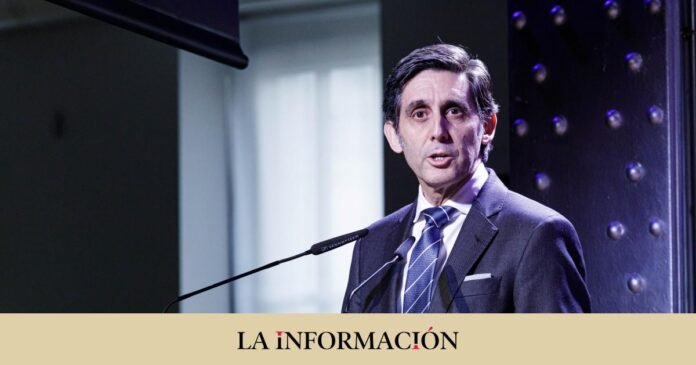Telefónica closed the first part of the year with an improvement in its forecasts for the rest of the year in terms of both revenues and profitability. The operator ended the second quarter with a significant improvement in net profit, thanks in large part to a reduction in the payment of Corporate Tax. Revenue grew by 0.9% to 10.1 billion euros. Net financial debt rose by €1 billion compared to March. The group chaired by José María Álvarez-Pallete announces a new strategic plan and foresees a second part of the year in which the Spanish market, which represents a quarter of its business, will not be affected by macroeconomic conditions.
During the period between April and June, the company added revenues of 10,130 million euros, representing a growth of 0.9%, affected by the negative impacts of the exchange rate and the effect of Argentina as a hyperinflationary economy. These figures allowed to have a flat operating result (Oibda). What has changed significantly has been the tax expenditure that plummets by 68.5% to 69 million. The reason: “the lowest tax base in companies with associated corporate tax”. This has allowed net profit to soar by 44%.
Given these numbers, the company has improved its forecasts for the rest of the year. In revenue it had raised an organic growth (excluding a series of points) of ‘low digit’ and now places it at 4%. In the operating result (Oibda) it places it at 3%. And it maintains unchanged the expectation of placing the ratio of capital investment (Capex) on sales at 14% (in the first half it stood at 12.7%). It also leaves the remuneration policy unchanged, with the dividend of 0.30 euros in cash payable in December and June 2024.
There are two other global variables that receive attention in Telefónica’s accounts. One is the net financial debt, which stood at just under 27,500 million euros. This represents an increase of €1,036 million during the quarter due to dividend payments, labour commitments of €231 million and currency impact. All this despite a cash flow of €842 million, which remains more or less stable compared to the same period last year.
The Spanish business
Spain, which represents just over a quarter of the group’s business, continues to be affected by strong commercial and competitive pressure in the sector. Revenues were maintained during the second quarter with a growth of 0.3%. One of the reasons compared to other periods can be found in the 14.5% decrease in the sale of terminals, “having reached a high penetration” in the customer base with convergent fiber and mobile packages. The operating result (Oibda) fell by 1% affected by the “extraordinary increase in wages”, although it stabilized progressively reflecting lower costs related to content (football) and other aspects.
The ‘number 2’ of the teleco, Ángel Vilá, has defended in the presentation to analysts – especially interested in the evolution in Spain before the commercial battle experienced in recent years – that there is no impact on the Spanish business due to the current macroeconomic conditions. He pointed to a “positive momentum” on the commercial side and a stabilization of Ebitda. “The Enterprise business used to feel the macroeconomic impact in the past and has had solid growth,” he said. They will adjust prices next year in case it is necessary to adapt to the situation.
The average revenue per customer with fiber, mobile and television (known in slang as ARPU) has remained at 91.5 euros in Spain, representing a growth of 1.5% – the price increase that took place in the first quarter was higher. Vilá argues that the worst trend of this ratio in the second quarter compared to the first has to do with a different revenue mix – with more weight of lower-cost products – and also with the end of the football season, which entails customer disconnections during the summer months.
Regarding the rest of the markets, revenues grew in all of them, with the only exception of Latin America: 4.4% more in Germany; 4.7% in Brazil, and 3.6% in the joint venture with Virgin in the United Kingdom. In Hispam they fall by 5.2% in reported terms, although in organic terms – some financial effects are excluded – they remain stable.
New strategic plan
In terms of specific verticals, Tech increased revenue by 36% during thebefore the quarter up to 456 million euros -without counting the acquisitions executed in the last year adds up to 29%-. More than 80% of the business comes from markets with stable currencies and, according to the company, managed and professional services and its own platforms have a “high weight”.
Apart from the business figures, the company has taken the opportunity to announce a new strategic plan for the period 2023-2026 that will be presented at the ‘Investor Day’ on November 8. The president of the company, José María Álvarez-Pallete, explains that it will be based on three axes: growth, profitability and sustainability. “The operator is in an advantageous position to capture all the growth opportunities of the digital age,” he explains.
This new strategic ‘roadmap’ replaces the one approved in 2019, which included measures such as the ‘spin off’ of Telefónica Infra and Tech, in addition to placing Spain, Germany, the United Kingdom and Brazil as strategic markets, excluding Hispam. This would be the first major Investor Day held in the last decade in the telecommunications operator.

